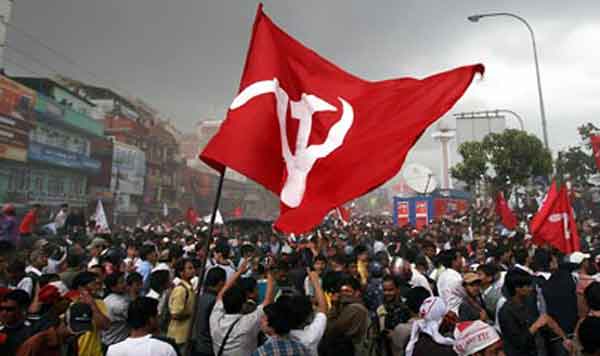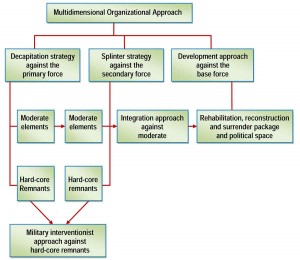India has been suffering from armed internal violence for the past four decades. Terrorists and insurgent groups have created havoc in various parts of India, targeting combatants and noncombatants alike. These groups have a great impact on the national security of India, both internal and external. Presently, India has many terrorist and insurgent groups, of which, Maoist insurgency remains the severest threat to India’s internal security. India’s response to tackling Maoist insurgency has been multi-pronged. Though this response has incorporated all the approaches, namely integration approach, developmental approach and military interventionist approach, they have not been able to achieve their objective fully. These efforts have often been plagued by lacuna associated with the federal structure prevalent in India, erroneous policy vectoring and excessive reliance on a single approach instead of following a blended approach.
A military interventionist approach would augur well against the primary force of the Maoists but can be counter-productive against the base force as it might cause collateral damage on a noncombatant population.
The current organisational approaches are only two-dimensional, i.e., they focus on splintering and decapitation. However, to have an effective approach against the Maoists, a multidimensional approach apportioned appropriately with other approaches, like developmental approach, interventionist approach and rehabilitation, is required. However, the effectiveness of such a multidimensional organisational approach lies in implementing other approaches in tandem, which are subsumed to be a part of this broad organisational approach and cannot exist or operate independently.
The rationale behind such a multidimensional measure against the Maoists is that the strength of this group is determined by its workforce constitution. Hence, an ideal organisational approach has to target this human capital of the Maoists. The Maoists, as a movement, are made of people from different strata, both literate people and illiterate tribals. The Maoists’ military formation, known as People’s Liberation Guerrilla Army (PLGA), is divided into three force levels. They are:14
- The primary force, which consists of hard-core, ideologically motivated members in platoon, company and central/state special action team formations, which move anywhere to participate in the war depending on the needs of the movement under the instructions of the commissions/commands.
- The secondary force, which consists of local members of areas, regions, etc., in guerrilla squads, special guerrilla squads, platoons and district/division-level action teams.
- The base force, which is the people’s militia, which forms the bulk of their strength consisting of tribals (adivasis).
Maoists, made up of different sets of people from diverse backgrounds, driven by different motivations, place serious questions on the viability of applying a single approach uniformly for all the segments or force levels. For example, a military interventionist approach would augur well against the primary force of the Maoists but can be counter-productive against the base force as it might cause collateral damage on a noncombatant population.15 Again, a developmental approach, which can impact the base force, may not be sufficient to veer away hard-core members of the primary force and secondary force. Hence, these compulsions dictate the approaches to be balanced, staggered and differential.
…in order to be successful, the strategy has to be necessarily supported by a strong and robust policing and intelligence apparatus.
Though an approach similar to an organisational approach has already been in place in India to contain the Maoists, it has been deployed only in a crude form, only to create vigilante groups and splinters among the Maoists. For instance, an anti-Maoist movement in Chattisgarh popularly known as Salwa Judum is believed to be propped up by the security forces against the Maoists.16 Similarly, various Maoist splinter groups in Jharkhand are believed to be tacitly backed by the security forces to nullify the Maoists.17 However, both these measures, believed to be backed by security forces, have had disastrous consequences. To put it more bluntly, the policy planners have failed to measure the impact (negative) or even anticipate the effects of their counter-measures and plan for the same. These facts provide a strong foundation to infer that the thought process with which these approaches have been planned and executed is out rightly utopian, lacking in anticipation and without factoring in the ground realities. Apart from these recent instances, no systematic or organised attempt has been made till date to conceive and implement an effective organisational approach against the Maoists, which is the need of the hour.
This organisational approach, which would attempt to orchestrate disintegration of the Maoists, has to primarily focus on the one main aspect, i.e., its workforce. It is obvious that the success of a well-conceived approach is directly proportionate to anticipating an event or set of events (including negative fallouts) that could unfold in future. This idea of anticipation is the most important criterion for policy planners, even at the drawing board stage of an approach.
This organisational approach has to be laid out on a broad canvass, encompassing three approaches: organisational disintegration through decapitation and splinter strategy, an integration approach and a developmental approach, engaging the Maoists in a staggered pattern (given below).
An organisational approach constituted by a strong decapitation and splinter strategy is the first step. Prior experience teaches us that standalone decapitation strategies have not been successful elsewhere in the world.18 However, there are contrarian views on the same. While historically scholars believed that a decapitation strategy impacted only communist groups and not the religious one, recent scholarly research, on the other hand, provides a paradoxical view that a stand-alone decapitation strategy is not effective against even Communist groups.19
Hence, in order to be successful, the strategy has to be necessarily supported by a strong and robust policing and intelligence apparatus. However, it would not be logical and prudent to assume that all key leaders are likely to be either killed or captured. This decapitation strategy should be directed only at the primary force levels of the Maoists, consisting of upper- and middle-management cadres. This should vector on the structural and functional Achilles heel (weakness), which is the key that determines the successful outcome.
A decapitation strategy should aim to remove the third- and fourth-level members, who act as the interface between the decision-makers and the decision followers.
Exploiting the weaknesses in the organisational structure of the Maoists is one of the important measures. The organisational structure of the Maoists is highly hierarchical. According to the party’s constitution,20 the highest decision-making body is the Central Committee (CC), which is elected at a party congress held once every five years. The military setup is headed by the Central Military Commission (CMC), consisting of the CC, under which the PLGA functions.
The political structure of the Maoists is arranged vertically, under the CC, as follows:21
- Special Area Committee/Special Zonal Committee/State Committee
- Regional Committee
- Zonal Committee/District/Divisional Committee
- Sub-Zonal/Subdivisional Committee
- Area Committee; local-level committees, such as village/basti/ factory/college party committee
- The primary unit of the party, which is the cell
A decapitation strategy should aim to remove the third- and fourth-level members, who act as the interface between the decision-makers and the decision followers. The current focus has been on the first and second levels, which, given the resilience of the Maoists’ structure (around 60 per cent of its core leadership is obliterated, yet it has still managed to survive), is bound to be ineffective. The interface removal process, when half complete at the middle-management level, would render the Maoists ‘inoperable’ and its decapitated levels ‘irreplaceable’.
A decapitation strategy should aim to cut off the resources by removing the nodes that act as facilitators for its financial and other resources. This strategy will have a twofold effect. By capturing or removing key Maoists resource facilitators, the Indian government would be able to track in two opposing directions, one to the organisational heads of the Maoists (level one and level two) and the other to the operational heads of the Maoists (level four and level five). Another outcome of this approach is that the Maoists would be drained of their resources, which would curtail their organisational and operational ability.
Continued liquidation of its leaders, either by arrest or by killing, is bound to render some sections of the Maoists moderated and, thus, approachable. This would be the ideal time for other approaches, like a splinter strategy, to work in unison.
A split or a division can be attempted by engaging in negotiations, offering amnesty, setting up rehabilitation schemes, etc.
Lessons from India’s experience with other insurgent groups could also enlighten us in this aspect. For example, In 2010, the Sheikh Hasina government in Bangladesh arrested and handed over the top leadership of the United Liberation Front of Asom (ULFA), including its chairman, Arabinda Rajkhowa; Sashadhar Choudhary, the outfit’s foreign secretary; and Chitrabhan Hazarika to India.22 This decapitation of ULFA’s higher echelons created a two-way split in the organisation, where the anti-talk section was headed by its elusive military chief Paresh Barua while the pro-talk faction was led by its arrested chairman, Arabinda Rajkhowa. Hence, a concerted decapitation action against the Maoist leadership is bound to render the group weak, fragile and prone to divisions.
The splinter strategy has to be employed against the secondary force levels of the Maoists, which should attempt to bring moderate elements out of the Maoist fold. A split or a division can be attempted by engaging in negotiations, offering amnesty, setting up rehabilitation schemes, etc. However, the success or failure of such a move depends upon timing. For instance, the Naxal movement, during its initial phases, between 1969 and 1972, was punctuated by multiple splits due to continued police action, death of key leaders, like Charu Majumdar, etc. However, most of the splinter groups that were created later were due to intraorganisational feuds rather that orchestrated actions by the government, as the Naxalites, in their later years, started to evolve into a unified entity. Had the government initiated an amnesty/rehabilitation scheme instead of attempting to put down the movement using brute force, the Maoist movement would have been weaker in terms of relative strength. Hence, the government’s inaction could be a barrier to the success of this strategy. Factoring this into account, a splinter strategy has to be formulated when the Maoist movement is perceived to be weak and riddled with internal strife. The removal of select leaders through a decapitation strategy would present the policymakers with such an opportune moment. For example, the Maoists have split into 15 organisations in Jharkhand alone.23
However, the Indian policy planners, instead of offering rehabilitation, aiming at dismantling and further political integration of the splinters, has backed these groups tacitly against the Maoists, which has led to spiralling violence and internecine conflicts.24 For example, Tritiya Prastuti Committee (TPC), a splinter group of the Communist Party of India-Maoist (CPI-M), is believed to have received tacit support from the Jharkhand police. Most of these splinter groups, like Popular Liberation Front of India (PFLI), have now grown and degenerated into criminal enterprises,25 extorting funds from the common man, as deserters from the Maoist groups have joined their ranks. Such new avenues present the renegade Maoists with an ideal alternative instead of having to integrate back into the political mainstream. Both these strategies should aim at initiating ‘individual exits’, wherein high-ranking cadres are either killed or captured.






